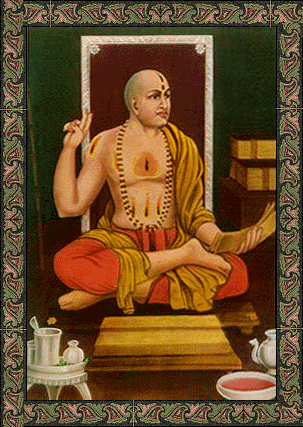

"Sripada Madhvacarya's philosophy is known as Dvaita. While strongly establishing the status of Visnu as Supreme Being, he emphasizes that there are two categories of realities: svatantram asvatantram ca prameyam dvividham matam (Tattva viveka 1)vede ramayane caiva purane bharate tatha
adavante ca madhye ca visnu sarvatra giyate
Harivamsa"In the Vedas, Ramayana, Puranas and the Mahabharata, from the beginning till end, and also in the middle, Visnu is glorified everywhere."
The aim of philosophy, he says, to realize the distinction or difference between the Independent Reality (The Supreme Lord) and dependent realities (jivas, world etc). There is order, regulation, mutual adjustment and harmony in creation. This shows that there is no unrestricted independence to all to act as they please. The realities that constitute this existence are dependent on the Independent Reality, the Supreme Lord, Vasudeva who explains, controls and inter-relates the dependent realities into t his existence.
This fivefold difference is collectively spoken of by Madhva as "Pra-panca". It is real and eternal.jivesvarabhida caiva jadesvarabhida tatha
jivabhedo mithascaiva jadajivabhida tatha
mithasca jadabhedo'yam prapanco bhedapancaka:
(Visnutattva nirnaya)(1) the distinction between Isvara and jiva
(2) the distinction between Isvara and jada (prakrti)
(4) the distinction between the jiva and the jada
(5) the distinction among the jadas, i.e, distinction between one inanimate object and another.
paramesvarena jnatatvat raksitatvatca
na dvaitam bhrantikalpitam
nahisvarasya bhranti:
(Visnutattva nirnaya)This scheme of pancabheda is not illusory - as it is cognized, maintained and controlled by the Supreme Lord; for there can be no illusions for God.
All the Upanisads without exception, glorify Hari who is the abode of infiite qualities as free from all imperfections:sarvatrakhilasacchakti: svatantro sesadarsana:
nityatadrsacicetyanta istho no ramapati
(tattvodyota)The Lord of Rama is the Supreme Independent Person possessing all adequate and unrestricted energies in regard to the cit and acit and He is unlimitedly cognizent. By His own will, He is the Supreme controller of both cit and acit who are of a different nature from His.
Because He is transcendental to material nature and is the controller of all that be, He is described as formless.gunavisistha - Full of qualities like omniscience etc, lordship, beauty, transcendence etc.dosa abhava visistha - free from limitations as sin, misery, liability to physical embodiment etc.
vangmanasa gocara - beyond the reach of mind and speech, transcendental.
a-dvitiya - One without a second, to be sought to the exclusion of everything else.
sarvartaka - the Supreme self, source of all existence, consciousness and activity of all else in the creation.
prakrtyadipravartakatvena taduttamatvat, naiva rupavat brahma (Brahma-sutra Bhasya) III - 2 - 14
He is the source of all:
Jiva:svabhava jiva karmani dravya kala sruti kriya
yat prasadad ime santi na santi yad upeksaya
iti sruterna sattadya 'pi narayanam vina
tat patanjali vindhyadi matam a purusartadam
(Anu vyakhyana)The nature, jivas, their karmas, ingredients, time, Vedas, interactions all these exist, function and are cognized only by Narayana's will and pleasure. They cannot exist without Him. Thus it is explained in the Srutis that everything depends on His control. So the philosophy of Patanjali and Vidhya etc., are not conducive for spiritual advancement.
Souls are conceived in Madhva's system as finite centers of conscious experience, each with a unique essence of its own. The essence of individuality is that one finite center of experience cannot possess, "as its own immediate" experience, the experience of another. It is this non-transferable immediacy of experience that distinguishes one self from another, in spite of their possessing certain similar characteristics. Each has a specific content of consciousness, reality and bliss and constitutes a focalization which is nowhere exactly repeated in nature. The nature of the souls is to be one of unalloyed bliss and pure intelligence. It is essentially free from any kind of misery or pain; though subjected to a natural gradation of intelligence and bliss in cosmic hierarchy of selves and subject always to the Supreme, in bondage "and in release". The sense of misery, which is bondage, is external to their essence and is brought about by a "real" though "misplaced sense of independence of initiative and conduct"ahamityeva yo vedhya: sa jiva iti kirtita
sa dukhi sa sukhi caiva sa patram bandha moksayo
(Visnu tattva nirnaya)He who undergoes happiness and misery, who is eligible for bondage and release, is the jiva. He knows himself as "I am" in all his states.
The jivas are reflected counterparts ('pratibimbamsa') of Brahman (Visnu). The bodies of the jivas, eternally present in Vaikuntha, the celestial abode of Visnu, are transcendental ('aprakrta'). Hence, they are called unconditioned-reflected-counterparts ('nirupadhika-pratibimbamsa') of Visnu. The bodies of the jivas of the material world are material; therefore, they are called conditioned-reflected-counterparts ('sopadhika-pratibimbamsa') of Visnu.
(i) Plurality of Souls - Madhva holds the doctrine of multiplicity of selves. He establishes that there are intrinsic or essential differences in the nature of the jivas (svarupabheda). The uniqueness of each individual experience, which forms the content of personality, is sufficient reason, according to Madhva, for the acceptance of 'jiva-bahutva-vada' (plurality of souls) and the distinctiveness of each individual. (ii) Gradation of souls - Madhva's doctrine of the Soul insists not only upon the distinctiveness of each soul but also upon an intrinsic gradation among them based on varying degrees of knowledge, power, and bliss. This is known as 'Taratamya' or 'Svaru pataratamya', which comes out all the more clearly in the released state, where the souls realize their true status. According to Svarupataratamya, the unreleased souls are divided into three grades (Trividhya):
Sri Madhva also speaks about the intrinsic differences existing among the "released" souls. Hiranyagarbha among the released (and in Samsara too) occupies a privileged position as jivottama. He accepts innate distinction among (released) souls into Deva, Rsi (Pitr, Pa) and Naras. The Devas are 'Sarva-prakasa' (fit to realize God as all pervasive), the Sages are 'Antahprakasa' (fit to realise God within) and the rest 'Bahihprakasa'.(1) 'Muktiyogya' (salvable),
(2) 'Nitya-samsarin' (ever-transmigrating)
(3) 'Tamoyogya' (damnable)
Madhva and his commentators have cited many texts from the Vedic literature (from Gita16.3, 5, 6, 18, 20; 8.3; Bhag. 6.14.5; Isa. Up 3 etc.), in support of the acceptance of the Traividhya among jivas who are entangled within the samsara. An intrinsic divergence of nature and faith into 'Sattvika', 'Rajasa' and 'Tamasa' which is rooted in the core of individual nature ('dehinam svabhavaja') as stated in the Gita, is the ultimate basis of this theory according to Madhva. This theory is developed from the doctrine of Trividha-Sraddha in the Gita. The term Sattvika, Rajasa, and Tamasa are applied to the jivas in their tripartite classification, according to Madhva, with reference to their basic nature of Caitanya going beyond the play of prakrti and its gunas: "yo yac chraddhah sa eva sah" (Gita 17.3). This is clear from Madhva's comment on the above verse, where he interprets the term "sattvanurupa" as "cittanurupa".
(iii) Self-luminosity of souls: The individual soul, as a sentient being, is admitted by Madhva to be self-luminious ('svaprakasa'). It is not merely of the form of knowledge ('jnanasvarupa') but is a knower ('jnatrr). The conception of self as a conscious personality is the same as it is in respect of God, expect for the fact that even the self-luminosity of the jiva is dependent on the Supreme, which makes bondage possible. Bondage:
pramadatmakatvat bandhasya
(Brahma Sutra Bhasya I - 1 - 17)Bondage is of the nature of ignorance.
Madhva calls his theory of bondage by the name of 'svabhava ajnana vada. Even though the jiva is a self luminous being, still, it is not inconceivable that he should become subject to ignorance of his own true nature and of the nature of God and of his true relationship with Him, as he is a dependent being, and part.svabhav ajnanavadasya nirdosavat na tad bhavet
(Anu vyakhyana)The theory that ajnana has the jivas for its locus and acts as a veil around them is not open to any of the difficulties that beset other theories as Brahma ajnana vada.
Jayatirta explains this natural ignorance as follows:
One of this veils the jivas own qualities and the other veils the true nature of God from him.1) it is in the nature of jiva.
2) it is real, not something imagined.
3) it establishes the Supreme Lord as Independent.
4) it establishes the jiva as dependent.
5) it covers jivas' true nature and the nature of the Lord and his relationship with Him from him. P 6) it is under the control of the Supreme Lord.
svagunacchadika tveka paramacchadika apara
(Bhagavata tatparya 10-81-13)
According to Madhva, the Lord actuates the latent power of prakrti known as maya and avidya and then the bondage begins. Though the jivas are dependent on God, (the theory of svabhava ajnana vada accepts that) the kartrtva (freewill) and bhoktrtva (enjoyer-mood) allows the avidya to act upon them. These faculties as well as the resultant false ego, intelligence, mind, the senses and the senses are all God-given. In ignorance, the jiva thinks that they are all under his control and his possessions. The fact is that they are our possessions subject to the will of the Lord. Due to contact with such material existence and the permeation of the consciousness through all these and the resultant attachment to them, the jiva regards the dualities as his own and subjects himself to continuous material existence in various levels. This is known as samsara.
Release:na ca karmavimamala kala guna prabhutimaccittanu taddhi yata:
(dvadasa statora 3-6)The true and final explanation of bondage is therefore the will of the Lord and not merely karma, ajnana , kala, gunas etc; for these are insentient and totally dependent on the Lord.
According to Madhva, the true knowledge of the soul's relation with the Supreme Lord can redeem it from this bondage. But even by the power of such knowledge, without the grace of the Lord, release is impossible:
ityaderna harim vina
jnanasvabhavato'pi syanmukti: kasyapi hi kvacit
jijnasotthajnanajat tatprasadadeva mucyate
(Anu vyakhyana)Release from samsara is possible only through Hari's grace. It is achieved by this process:
1) Discipline of sincere study of sastras and proper association 'jijnasa'.
2) This sets one's doubts at rest, and clears the ground for meditation.
3) Constant meditation on the Lord in loving devotion guarantees direct vision of Sri Hari.
4) Those who have such vision receive the grace of Sri Hari.
mahatmya jnana purvastu suddhrda sarvato adhika
sneho bhaktir iti proktas taya muktir na ca anyaya
(Mahabharata tatparya nirnaya I-86)The firm and unshakable love of God, which rises above all other attachments, based upon an adequate knowledge and conviction of His glories, is called Bhakti. That alone is the process for release - nothing else.
[Modified version of a posting to soc.religion.vaisnava by Nathan Parker, 1995.]bhaktya jnanam tato bhaktis tato drsthis tatas ca sa
tato muktis tato bhakti: sa eva syat sukha rupini
(Anu vyakhyana iii-4)Sri Madhva explains the process of bhakti:
1) devotion
2) understanding of one's original position
3) devotion
4) vision of Lord
5) devotion
6) liberation
7) devotion - essence of bliss and final accomplishmentharer upasana ca atra sadaiva sukha rupini
na tu sadhana bhuta sa siddhir eva atra sa yata
(Brahma-sutra bhasya IV - 4 - 21)The worship of Sri Hari bestows an unalloyed bliss in itself. It is not a means to any further end. It is the accomplishment itself and the fulfillment of our real self.
nityasiddhatvat sadrsyasya nityanandajnanade;
na bhakti jnana adina prayojanm ityato braviti:
ambuvadagrahanattu na tathatvam
ambuvat snehena/ grahanam jnanam/
bhakti vina na tatsadrsyam samyag bhivyajyate
(Brahma sutra bhasya 2.2.19)The essential nature of jiva's relationship with the Lord, his consciousness, bliss etc are all constitutional - hence they don't depend on sadhanas like bhakti, jnana etc. This is explained in the Brahma-sutra II-2-19: ambuvat; When all the processes are united with a loving, deep attachment with the Lord it is like the reflecting surface of the water. Without this loving devotion the vision of the Lord is impossible and the manifestation of one's constitutional relationship with the Lord is also impossible.
![[BVML Home Page]](../../grfx/bml_logo.gif)
